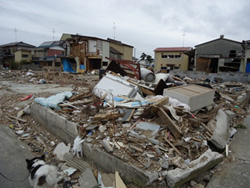



 |
 |
 |

|
Translation from an article by Shibasaki
MAHAYOGI YOGA MISSION, Kyoto, Japan
This is a report from a member of the sangha in Kyoto who applied to serve as a medical aid at one of the areas devastated by the earthquake and tsunami. She had unexpectedly become a nurse one or two years earlier, and had taken a job at a hospital in Kyoto. Later on, she quit that job and went on to learn and serve at the Kalighat Home for the Dying [established by Mother Teresa,] in Kolkata, India. On the day she left for Kolkata, the great Tohoku earthquake and tsunami struck Eastern Japan. Of the many humanitarian aid organizations that send medical professionals to disaster areas, she chose the one in which she could serve as a nurse, and more importantly, would allow her to offer other services as well. The following are her own writings about her experience.
 Where there used to be houses...
|
I volunteered to be a medical aid at Ishinomaki, Miyagi prefecture for two weeks starting June 6th, registered under an organization of nurses. I served at a primary school where 230 people were still living as evacuees. Three months have already passed, or should I say, it has only been three months since then. The local homes are still in ruins. The clock stopped at 2:46 p.m. Aftershocks are still happening. Cars are on top of the gravestones that were dug out by the tsunami. Piles of rubble keep rising up every day alongside the roads. Along the tidal line, the roads are waterlogged; strong odors emanate from the sludge and rotten fish. I was told this odor that I had never experienced before was mixed with the odor of decaying corpses. The air is full of dust. I have to wear a mask all the time. The sludge in the runoff from the factories contains either poisonous chemicals or hazardous bacteria released from exploded sewage pipes. They have become airborne and are floating around, so many evacuees and rescue workers are suffering from respiratory diseases such as bronchitis and pneumonia. Many flies are breeding. When I go to the garbage station, I see them fly by like fireworks. The temporary lavatory is privy style, so it has become a breeding ground for flies and other insects. The Self-Defense Force cars come and go. There are about 20 cars permanently stationed at some shelters, as if this were a civil war zone somewhere.
It strikes me that many evacuees calmed down a bit just at the time when they started making serious efforts to find a way to get on with their lives, and they then started to speak about their experiences from the earthquake-tsunami. A woman appeared and lamented, “We saw the bottom of the ocean during the tsunami. I can’t sleep.” Another woman is telling us about a voice that kept calling “Help… help…” that night in the dark and is still ringing in her ears. She said that after some time, the voice gradually vanished. There was a man who couldn’t stop feeling guilty about the way he embraced his family with such joy upon being reunited with them while so many others who had lost their loved ones looked on. A dog who was also a victim could not bear to look at the waves anymore out of fear. The number of alcoholics has increased at the shelters. I heard the pleas of those who could not sleep from the pain and sorrow of losing their families and their livelihoods, and from the stress of not knowing how they are going to survive completely alone. Hearing each story, I felt that it was a miracle that these people were alive at all.
Family, job, memory, everything—destroyed. No matter how hard we try to come up with a positive plan, we are not able to achieve much because of the demoralizing obstacles that continually rise up in our way. Everything is vulnerable. Even the colleague who was working near me was burnt-out and defeated.
Now is the time to move into temporary housing. Construction has been taking place in a hurry so that the evacuees in the shelters can relocate by the middle of August, but I heard that this seems unrealistic and will likely take longer—probably until Autumn. People are concerned and worried about their futures, even more so because at the shelter the meals are provided and there is no cost for heating and lighting, but when they move into the temporary housing units these expenses will have to be paid by themselves.
Still, despite the great hardship, some have experienced something positive—something for the better. I have heard powerful stories of realization and gratitude from knowing that, while one cannot live alone, one can live supported by others, or live in the moment without worrying about the future. The profound truth of these realizations cannot come to one’s heart, unless one actually lives through this type of life-changing adversity.
There was a child who wrote: “What I can do right now is just look forward and see what is in front of me,” “I hate the tsunami so much, but I was able to meet so many people through this disaster, and have received such courage that now I can live anywhere and stand strong. When I become an adult, I want to be a fine person who can help others, and show myself being a fine person to those who have helped me.”
When I was in the affected areas, I too slept in a sleeping bag on the hard floor huddled with many others. The repeated aftershocks worried me. I ate instant food, which I usually do not eat. Hearing the stories about the unbearable circumstances faced by survivors who spent the whole night of the disaster sitting on the floor, or who, when rescue finally did come, were given only a sip of water in a plastic bottle a single rice ball to last them the whole day or a meager slice of bread to be split among four children (so they were always hungry), made me realize that, until then, I had been taking the way I live for granted. When speaking with evacuees, they repeatedly made me see that one can feel and understand other people’s suffering only when one experiences such suffering first-hand.
I resolved that from that moment on, I would do whatever I could for them not to revert to the same conditions as before, but rather to renew our society and transform it into one in which life and peace can be treasured. Talking with gurubais, I realized that what we can do as disciples of Shri Mahayogi is to inspire action to expand the circle of yogic votaries who understand the true meaning of life.
|
Upon her return to Kyoto, Shibazaki continued working for the people in this area. She created a network for collecting and sending donations of vegetables, food products, utilities and blankets through trustworthy contacts who would deliver them directly to those in need. In August, she returned to the area to check the condition, see how the support network was functioning and report back to those who had contributed the items. She is currently communicating directly with the survivors to find ways of supporting them according to their needs. This winter she is planning to accompany the children of the affected families on a visit to Hokkaido, one of Japan’s northern islands. Her work continues to this day.
<— BACK |